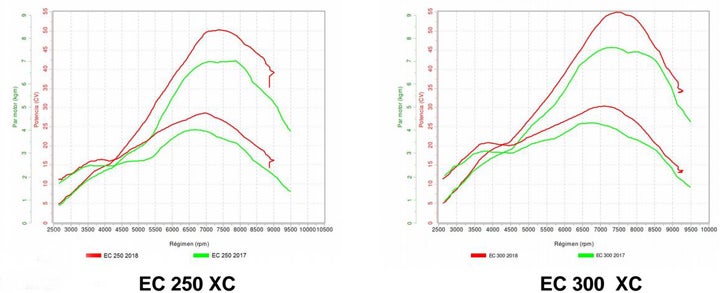You are using an out of date browser. It may not display this or other websites correctly.
You should upgrade or use an alternative browser.
You should upgrade or use an alternative browser.
EC vs XC
- Thread starter J. JuJu
- Start date
CDN Rick
Silver Level Site Supporter
Sorry 2018, really considering a new scooter.
EC -Enduro bike, has lights, horn,GasGas branded expansion chamber and FMF Silencer
XC - Cross Country bike, No light, no horn, just slightly stiffer springs, comes with full FMF expansion pipe and silencer.
Very few differences really. The big difference is lights or no lights.
Just noticed your location. If you are ever in the Niagara Region and want a quick test ride of an '18 GP250 my bike is always available to anyone who wants to buy from Lang's.
thumperrider1
New member
I don't find the XC too stiff. You can make it pretty soft (too soft IMHO) with just clicker adjustments. I'm 175lbs and installed stiffer fork springs (.44's).
https://www.dirtbikes.com/2018-gas-gas-first-ride-review/
https://www.dirtbikes.com/2018-gas-gas-exxc-models-announced/
https://ultimatemotorcycling.com/2017/05/31/2018-gas-gas-xc-300-ec-review-10-fast-facts/
https://www.dirtrider.com/2018-gas-gas-ec-xc-300-review
https://dirtbiketest.com/fresh-dirt...18-gas-gas-ec-and-xc-300/#v3Eh160F0cECqlE0.97
I have read in one or two reviews (I can't find them now), that the suspension on the EC feels softer than the XC. My dealer says he didn't feel a difference.
But... the Beta-Loving Aussie guy at CrossTrainer says the XC has "slighter firmer suspension." So, there's that:
https://www.youtube.com/watch?v=-xtdwsLY3z8
I've also heard (and posted below), that the EC is slower to rev and more linear than the XC. Without consulting a parts fiche, that could be ECU tune, fly wheel weight, or power valve spring adjustment. Not to mention someone's wild imagination.
My dealer says he has been through the motors and they are identical, down to the FWW which is also the same. He says the difference in performance is soley due to the pipe. Put the EC pipe on the XC and the XC will be tamed and smooth. Put the XC pipe on the EC and it transform into the fire-breathing dragon that is the XC.
Other noted differences:
Here is a pair of dyno charts that compare the 2017 and 2018 XC models:

In case you wanted to know about vibes:
https://www.dirtbikes.com/2018-gas-gas-exxc-models-announced/
https://ultimatemotorcycling.com/2017/05/31/2018-gas-gas-xc-300-ec-review-10-fast-facts/
https://www.dirtrider.com/2018-gas-gas-ec-xc-300-review
https://dirtbiketest.com/fresh-dirt...18-gas-gas-ec-and-xc-300/#v3Eh160F0cECqlE0.97
I have read in one or two reviews (I can't find them now), that the suspension on the EC feels softer than the XC. My dealer says he didn't feel a difference.
But... the Beta-Loving Aussie guy at CrossTrainer says the XC has "slighter firmer suspension." So, there's that:
https://www.youtube.com/watch?v=-xtdwsLY3z8
I've also heard (and posted below), that the EC is slower to rev and more linear than the XC. Without consulting a parts fiche, that could be ECU tune, fly wheel weight, or power valve spring adjustment. Not to mention someone's wild imagination.
My dealer says he has been through the motors and they are identical, down to the FWW which is also the same. He says the difference in performance is soley due to the pipe. Put the EC pipe on the XC and the XC will be tamed and smooth. Put the XC pipe on the EC and it transform into the fire-breathing dragon that is the XC.
Other noted differences:
The spent fuel charge exits the exhaust port and blows through a double-walled expansion chamber on the EC and a Gas Gas-spec FMF unit on the XC; that is the only difference in the tuning specs between the two models. Both are silenced by an FMF Powercore 2.1 muffler. Interestingly, the ECs in our test group were also fitted with spark arrestors, but Gas Gas tells us that neither the EC nor the XC will be equipped with a spark arrestor when they leave the dealerships.
The pipe and spark arrestor combo definitely made a noteworthy difference in the power delivery on the EC when compared to the XC. Both engines can chug along at trials bike speeds, but our test EC felt a whole lot more linear than the XC. Both will pull with authority, but the XC does so with a lot more snap throughout the rev range. The EC simply feels smoother and tends to work better on tighter and more technical trails, especially for novice riders, whereas the XC is clearly going to be better in wide open spaces and/or for more aggressive riders.
Ergonomically speaking, the EC and XC are very comfortable motorcycles, with a slim layout, a comfortable gripper-style seat and footpegs that offer a stable platform for the rider?s boots. Booth mentioned that he prefers the bend of the handlebars on the XC over the bend on the EC.
Here is a pair of dyno charts that compare the 2017 and 2018 XC models:

9. The 2018 Gas Gas EC 300 version is slightly different from the XC. The big change is that it has a lighting kit and computer, though it feels very similar to the XC model. Other changes include are a Spanish-sourced exhaust pipe (both have FMF mufflers), and Gas Gas branded handlebars. The plastic switchgear for the lights and starter were a bit oversized (and seemingly crash-vulnerable) for such a capable off-road bike, but highly functional. Riding the EC back to back with its XC sibling, the additional weight of the headlight was noticeable, as was a slightly slower rev and pick up through the gearbox. Still, the EC is not detuned in any sense of the word.
The EC’s power comes on almost immediately, but there is very little hit or jolt – it is extremely smooth, torquey, and usable. It builds in a linear fashion to a strong upper end of the bottom power/mid-range. As with most 300 engines, the “powerband” is shifted lower in the rpms compared to 250 two-strokes. Once you get past the mid-range power, there is no reason to wring it out as it doesn’t make that much more power on top.
The XC’s power was noticeably different. Right off idle it was as smooth, if not a little mellower than the EC, but there is a definite hit of power that comes on pretty low in the rpm and it pulls harder than the ECs midrange, or at least to our butt dynos. You can categorize these two power characteristics as, one for the mellow, smooth, chugging type rider (EC) and one for the aggressive racer that puts a priority on being able to snap the font end up without hesitation or needs instant power to hammer through an endurocross-like section of trail.
Power is also the biggest difference between the EC and XC and it all comes down to the only difference between the bikes, the exhaust system. The EC has one of the flattest and most constant torque curves of any two-stroke. It makes a lot of torque right off idle and in comparison to some bikes does not make a ton on top. But it is always enough and it is always there. It is the kind of engine that you never need to use the clutch because it does not bog down. Or on the EC you are using it a lot to make the engine rev up quicker. By comparison the XC has a more lively throttle response with the same bottom torque and a faster pull through the power. Not knowing any better we’d say it felt like the XC had a different ignition with a lighter flywheel and a more aggressive curve though we were assured the ignitions were identical between the bikes. The other difference between the bikes was the use of a spark arrestor muffler on the EC bikes we tested (not standard).
The XC never needed the clutch to bring the bike on the pipe but the EC wanted the rider to give it a little clutch for a quicker pick-up. Both bikes will rev out plenty far and have a tell-tale sign-off right after peak power. A proper rider would have already shifted.
Read more at https://dirtbiketest.com/fresh-dirt...18-gas-gas-ec-and-xc-300/#fSvpdPwOM6QjPXvf.99
Of note is that there is no difference in the suspension between the EC and XC bikes nor did we feel like there would need to be based on how well it worked. The handling has the bike wanting to follow the front wheel with a planted stability, so the turning was confidence inspiring.
Read more at https://dirtbiketest.com/fresh-dirt...18-gas-gas-ec-and-xc-300/#fSvpdPwOM6QjPXvf.99
In case you wanted to know about vibes:
The Gas Gas torque and chug is still alive and well. Starting with the power, since it is the only thing comparable, it has been livened up and is what riders choose 300cc two-strokes for. Yet even in power the biggest news here is the reduction in vibration. Adding a headstay to the engine and attaching it to the frame plus we suspect a lighter crankshaft with a better balance seem to have paid off.
Last edited:
CDN Rick
Silver Level Site Supporter
Hearing word that the suspension is actually identical on the two bikes, and internet lore alone is making us think they are different. 
I thought I recalled reading somewhere that they were different, but it wouldn't be the first time I've been wrong about something.
Maybe Girard could shed some light on this one?
I thought I recalled reading somewhere that they were different, but it wouldn't be the first time I've been wrong about something.
Maybe Girard could shed some light on this one?
Last edited:
CDN Rick
Silver Level Site Supporter
Suspension is identical on EC and XC.
Didn?t think it?d be long before you sauntered by with some facts for us mere mortals.
Thanks much.
Jetster220
New member
I'm back, did it and pulled the trigger today, ordered a new 2018 XC250. Traded away the other blue bike.
Thanks everyone !
Congrats man! You are going to love it.
CDN Rick
Silver Level Site Supporter
I'm back, did it and pulled the trigger today, ordered a new 2018 XC250. Traded away the other blue bike.
Thanks everyone !
Congrats! Be sure to come on back and join the conversation. You?re gonna love it!
Similar threads
- Replies
- 0
- Views
- 377
- Replies
- 6
- Views
- 316

